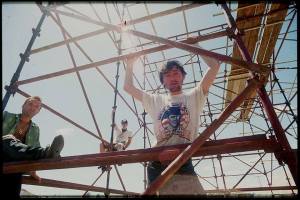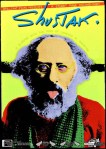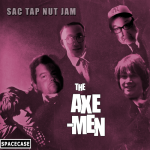Stu Kawowski (AKA Stuart Page) of The Axemen Interview, Part Two
Reprinted From: http://boredout305.tumblr.com/day/2013/09/14

Ryan: What inspired the Axemen to record Three Rooms: An Elton John Tribute Album (1992).
Stu: I remember that time period. Although it was released in 1992 we actually recorded it in 1984 or 1985. Nevertheless I can’t recall why in the hell we decided to do that record. I was living in Christchurch. Steve and Bob were sharing a flat that we called Peterborough Studios; we had done up the whole upstairs of their place and dedicated it to playing music. Steve was brewing coffee wine. We were all probably a bit wasted on his coffee wine. I remember singing “Rocket Man.” I think we only intended to do one song. As a joke we carried on with a whole pile of Elton John songs. It was one of those nutty things that we would do. I don’t think we had an organized plan to do Elton John covers.
Ryan: Organized and the Axemen are not synonymous.
Stu: Yeah.
Ryan: I lost track of you after 1992. What were you doing after The Axemen wound down? Were you pursuing film and photography?
Stu: In 1992 I hooked up with a couple of dudes and tried to set up a film company. We had two names. One was Eclipse Films. I was making music videos under that name. The other name was Māori: Te Aō Mārama Productions. Under that name we made a documentary about an old Māori woman, Ana Tia, who ran an inner-city marae (communal place). She would help out kids who moved to the city from the country and got into trouble. She would visit them in the jails and teach them traditional Māori waiata (songs) and haka— Māori war dance. That film, Te Whaea: Mother Of Change, ended up going to Leipzig, Germany and won an award. I was responsible for doing these advertising slides for a couple of cinemas in town as well. That was just to bring in cash for the business. I did that for a few years. The business didn’t pan out in the end. It wasn’t very lucrative. After the business ended I decided I wanted to learn more about film lighting. I ended up doing film lighting for ten years or so. I worked on commercials and feature films.
Ryan: Shustak (2009) was a big undertaking for you. I know Shustak died before you completed the film. How long had you been working on the film when he passed?
Stu: Shustak had a heart attack. I was in Europe when it happened. Someone had written to me and told me that he wasn’t well. I thought, “Oh shit. Don’t go yet, old man.” I came back to New Zealand and borrowed a camera from someone. I went down to Christchurch and asked Shustak to do some filming. He wasn’t very keen. I was there for two weeks and I only filmed him once. I went back down a few months later and managed to do one more session with him. I had enough footage to apply for some funding by that point. I wanted to do a small film. I applied for about $16,000. I was actually carrying Shustak’s coffin in Christchurch when the letter was delivered in Auckland saying that I had gotten the funding. Shustak was convinced that I’d never get it. He’d say to me, “No one will give you funding to make a film about me.” I was just focusing on making a small film on Shustak. But then this guy, Elliot Landy—who was the primary photographer at Woodstock—found out that I was doing this film on Shustak. He lives out in New York. Landy said, “Oh, man, you’ve got to come out and film us. We’ve got much more interesting things to say about Shustak than what he told you.” I realized at that point that Landy was right and that the project had suddenly become enormous.
 Ryan: Shustak comes across as a very divisive figure in the film. Were you expecting that?
Ryan: Shustak comes across as a very divisive figure in the film. Were you expecting that?
Stu: Shustak was a very important person in my life. I wanted to make something celebrating all of his great photography; I didn’t want his life to go unnoticed. There wasn’t much information on Shustak out there. A few mentions in magazines.
Ryan: There still isn’t much out there on him. You did a great service for him.
Stu: There’s a book coming out with some of his photographs of Ethiopian Jews in it but there’s nothing solid out there on him, focusing exclusively on his work. I doubt I’ll do it. I spent seven years of my life on the film. Someone should pick up the baton and charge with that one. It’d be a big job but someone could put together an incredible book of Shustak’s work. There’s so much material. I’ve scanned thousands of things that he created: photographs, writings and film scripts.
I was going to Europe with this Māori music group a lot between 2002 and 2006. I’d get my return travel to NZ rerouted through USA rather than back through Asia. It cost me another five hundred dollars but it allowed me to stop off in New York and film people like Harvey Zucker from A Photographers Place bookstore and Elliot Landy up in Woodstock. I also filmed Shustak’s family, friends and ex-wives. Some of them were hard to find, living right on the border of Mexico. Shustak was a guy you either loved or hated. His kids all had good and bad things to say about him. His ex-wives didn’t speak too kindly of him. He did some really great photography. For its time and place it was pretty groundbreaking. Nowadays it isn’t but back then it was. He was photographing graffiti and black Jews so long ago.
Ryan: And taking all those great photos of jazz musicians.
Stu: Right. Who knows where all the rest of those jazz photos are? He had a habit of losing stuff. He was a difficult guy to make a film about.
Ryan: An important person in The Axemen story is Tom Lax. How did you meet him?
Stu: Tom visited New Zealand back in 1992. He collected a whole bunch of albums and cassettes—including Axemen LPs and stuff on Bruce Russell’s Xpressway label. Tom had really select taste. Tom came at a time when you could buy rare New Zealand vinyl for quite cheap. He picked up a whole pile of records—albums you pay one hundred dollars for today he was picking up for a couple of bucks. Tom told me how he got interested in New Zealand music. Some record distributor had been stiffing him on some orders he had been putting in for Australian records. Tom got pissed off at this guy. The distributor said, “Hey, I just got a bunch of records in from New Zealand from this label Flying Nun. Do you want those instead?” Tom said, “Okay. Send me two copies of everything that’s good and one copy of everything else.” Of course the distributor sent him two copies of everything. The records all arrived on a Friday. Tom went to see a band play that night with some friends. They got a bit drunk and decided to go back to the record store to listen to this New Zealand crap. They ended up staying at the record store the whole night. Tom played The Axemen’s Three Virgins over and over again that night. It was by chance that he found out about us. When Tom moved from Columbus, Ohio to Philadelphia all of the kids from Columbus would visit him at the Philadelphia Record Exchange and he’d play them The Axemen. I think Jared from Times New Viking was pretty taken by it. Jared told him, “Oh, you’ve got to release something by these guys.” Eventually Tom did.
Ryan: And then you ended up touring with Times New Viking.
Stu: That was an awesome tour. We did about twenty-six shows. Some were great, others were not. The show in Philadelphia was a complete disaster in my opinion, due to someone drinking a whole lot of alcohol. But then a friend of mine in Auckland told me his friend in Baltimore—who had gone out to the Philadelphia show—said that it changed his life. I thought it was the worst show of the tour. Those Times New Viking guys were great. It was a gift to tour with them.
Ryan: You toured Australia in 2011 and released a single with the late Brendon Annesley.
Stu: Yeah, Brendon was a darling. A guy called Samuel Miers and his friend Daniel Oakman have a band called School Girl Report. They had planned to do a music festival at Batemans Bay which is about four hours south of Sydney on the coast. Sam rang me up one day and said, “We’ve only got the budget for one overseas band and we want it to be The Axemen.” I thought that was exciting. Everyone wanted to do it. Bob (Brannigan) had left the band after the American tour. Dragan had been playing with us for years and we added William Daymond on bass—a young guy from Wellington. This whole festival they had planned turned into a nightmare; just the bureaucracy of fire laws and city inspectors, etc. Sam, without missing a beat, organized a tour of Australia for us. He got all of these other bands interested who knew and liked The Axemen. We started in Brisbane. We played with Satanic Rockers, Mad Nanna, Meat Thump, Blank Realm, Cock Safari, xNoBBQx, Circle Pit, School Girl Report and others…
Ryan: We (Spacecase Records) wrote you to release a single but you had so many good songs we went ahead with an LP.
Stu: Yeah. We were trying to squeeze eight songs onto a 7”. It wouldn’t work. Not unless we played them at 16 RPM. We’re still trying to get a tour together. We’re playing it by ear. I’m pretty busy with my current film project.
Ryan: The OMC documentary?

Stu: Yeah. It’s probably the biggest thing I’ve ever taken on. I’m directing and editing it. I’ve also been talking with Mike McGonigal at Yeti. In the last issue of Yeti he included some reproductions of the posters I did back in the ’80s. It was his first full-color issue. He also included a 7” containing a Great Unwashed song “Space Bikie” that was recorded at my old place back in Christchurch. I’ve been talking with Mike for a while about doing a book of old posters from Christchurch from that time period. It wasn’t just me. Lesley MacLean, who’s an old girlfriend of mine, she was a very good screen printer and designer. Ronnie van Hout was another great screen printer. He did posters for The Clean. I reckon it’d be a great project. I’ve got at least fifty Axemen posters at my house alone.
Leave a comment